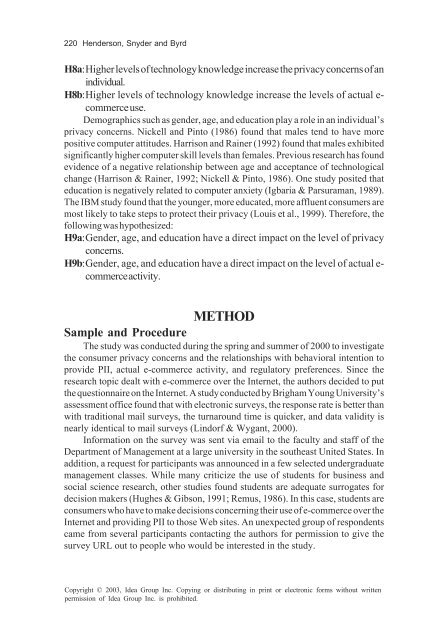www.sharexxx.net - free books & magazines
www.sharexxx.net - free books & magazines
www.sharexxx.net - free books & magazines
You also want an ePaper? Increase the reach of your titles
YUMPU automatically turns print PDFs into web optimized ePapers that Google loves.
220 Henderson, Snyder and Byrd<br />
H8a:Higher levels of technology knowledge increase the privacy concerns of an<br />
individual.<br />
H8b:Higher levels of technology knowledge increase the levels of actual ecommerce<br />
use.<br />
Demographics such as gender, age, and education play a role in an individual’s<br />
privacy concerns. Nickell and Pinto (1986) found that males tend to have more<br />
positive computer attitudes. Harrison and Rainer (1992) found that males exhibited<br />
significantly higher computer skill levels than females. Previous research has found<br />
evidence of a negative relationship between age and acceptance of technological<br />
change (Harrison & Rainer, 1992; Nickell & Pinto, 1986). One study posited that<br />
education is negatively related to computer anxiety (Igbaria & Parsuraman, 1989).<br />
The IBM study found that the younger, more educated, more affluent consumers are<br />
most likely to take steps to protect their privacy (Louis et al., 1999). Therefore, the<br />
following was hypothesized:<br />
H9a:Gender, age, and education have a direct impact on the level of privacy<br />
concerns.<br />
H9b:Gender, age, and education have a direct impact on the level of actual ecommerce<br />
activity.<br />
METHOD<br />
Sample and Procedure<br />
The study was conducted during the spring and summer of 2000 to investigate<br />
the consumer privacy concerns and the relationships with behavioral intention to<br />
provide PII, actual e-commerce activity, and regulatory preferences. Since the<br />
research topic dealt with e-commerce over the Inter<strong>net</strong>, the authors decided to put<br />
the questionnaire on the Inter<strong>net</strong>. A study conducted by Brigham Young University’s<br />
assessment office found that with electronic surveys, the response rate is better than<br />
with traditional mail surveys, the turnaround time is quicker, and data validity is<br />
nearly identical to mail surveys (Lindorf & Wygant, 2000).<br />
Information on the survey was sent via email to the faculty and staff of the<br />
Department of Management at a large university in the southeast United States. In<br />
addition, a request for participants was announced in a few selected undergraduate<br />
management classes. While many criticize the use of students for business and<br />
social science research, other studies found students are adequate surrogates for<br />
decision makers (Hughes & Gibson, 1991; Remus, 1986). In this case, students are<br />
consumers who have to make decisions concerning their use of e-commerce over the<br />
Inter<strong>net</strong> and providing PII to those Web sites. An unexpected group of respondents<br />
came from several participants contacting the authors for permission to give the<br />
survey URL out to people who would be interested in the study.<br />
Copyright © 2003, Idea Group Inc. Copying or distributing in print or electronic forms without written<br />
permission of Idea Group Inc. is prohibited.









